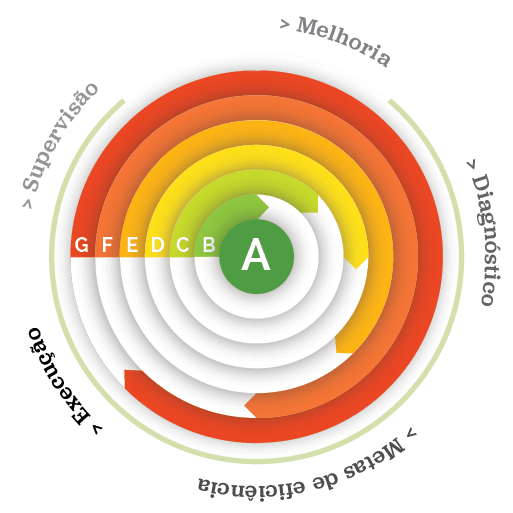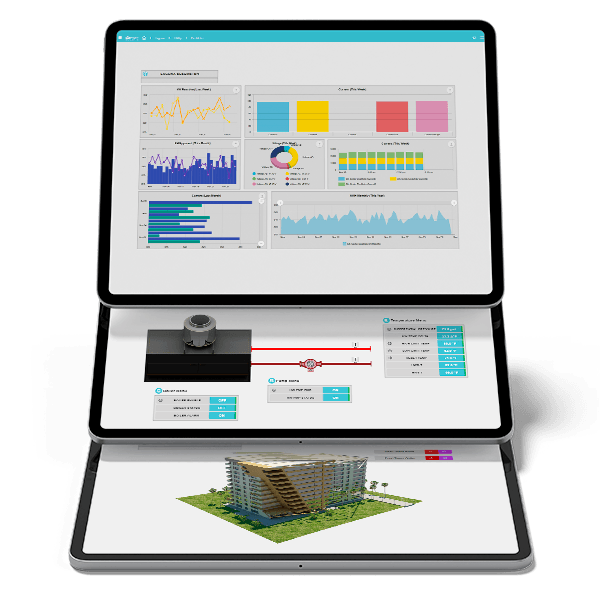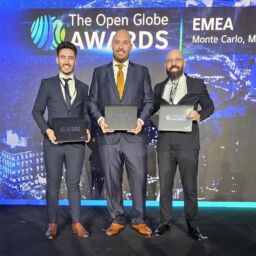
- HVAV Control System
- Lighting Control
- Electrical Panel Monitoring
- Energy Analysis & Counting
- Load shedding
- Water Consumption Count
- Medical Gas Monitoring
- Report Alarms
- ModBus, BACnet and KNX system integration
- 4000 Data Points
- Interaction with UMinho software through API
3B’s Research Group (Biomaterials, Biodegradables and Biomimetics) was created in 1998 at the University of Minho and supports a multidisciplinary and highly qualified team working at the interface of biotechnology, biology, biomedical engineering and materials science.
The group’s main research areas include the development of new biomaterials, drug delivery, tissue engineering, regenerative medicine, nanomedicine, in vitro disease models and stem cell isolation and differentiation.
The group also leads the European Institute of Excellence in Tissue Engineering and Regenerative Medicine, which has branches in 22 locations in 13 different countries and has now seen its new headquarters building come to life at AVEPARK, located in Caldas das Taipas in Guimarães.


TERM RES HUB building is an extension of the headquarters building of the European Institute for Excellence in Tissue Engineering and Regenerative Medicine.
Being independent buildings, they are complementary and it is assumed that they share spaces and equipment generating a flow of people between the two structures.
The area of this new building is divided into three floors, consisting of 9 laboratories, open space working areas for researchers and complemented by an administrative area (secretariat and meeting rooms), work offices, common room and support infrastructures such as toilets, changing rooms, technical and warehouse areas.
The building also includes two clean rooms with precise atmospheric control and a very low number of particles suspended in the air.
Climate-controlled rooms and laboratories are thus immune to contamination and enable the translation of laboratory results into applications for mankind to be accelerated.
With all the technical conditions that a laboratory building requires, it must be managed automatically, keeping the building within the conditions of comfort and safety required by the user.
To this end Wisebuilding® has implemented a BMS system, designed as a “tailor-made suit”.
In order to standardise the whole infrastructure of the Institute, the GTC system of the existing building was adapted and integrated into a single and intuitive interface common to the new building, thus encompassing the multiple technical equipment of both the existing building and the one developed from scratch by Wisebuilding®this allowing the user to visualise information and operate (depending on the access level) on both buildings of the Institute.

All laboratory and validated environment requirements have been taken into account, with all actions performed and the user who performed them being registered, as well as all system navigation, meeting FDA-CR21 (used as the maximum exponent legislation in this area).
Funcionalidades Implementadas
Water Production
Monitoring and control of chillers and boilers with an optimised algorithm focused on the real instantaneous needs of the building and based on the outside temperature, thereby achieving a binomial between thermal comfort and energy consumption. Equipment integrated by Modbus protocol.
Solar Thermal Production
Control of hot water production using the solar system, using sensors on the panels, tank and circuit to optimise production using this resource.
Water Distribution
Monitoring and control of the circulating groups (pumping) according to the request of the equipment and using sensors in the return of each circuit for continuous analysis of the group's need for work, faults and rotation between pumps. Integrated equipment using sensors and physical points.
Air Treatment Units
Monitoring and control of the air handling units (AHU), ensuring the treatment of the air insufflated in all areas of the building in order to maintain the variables of temperature, relative humidity and air quality at values of comfort and safety for the occupants and experimental materials in all spaces inherent to the area of influence of each machine. This control in part of the system (old building) is done using sensors and actuators interconnected to the BMS, and in the new building these units have a dedicated control with Modbus interface;
Air Cleaners
Given the purpose of the building and its requirements, it is necessary to use ultraviolet light to sanitise the air blown into the spaces. This equipment was integrated by Modbus communication, with the start-up and monitoring of the same being done by BMS.
Ventiloconvectors
Monitoring and control of the ventilation-convector terminal units (VC), guaranteeing the adjustment of the air temperature in the spaces associated with them. This control was carried out using digital thermostats with Modbus communication, allowing the user to block local access through BMS.
Fans
Monitoring and control of the fans responsible for extracting contaminating gases from the laboratories (hoods, hoods, extraction arms and ventilated cabinets) and of the insufflation fans for compensation/pressurisation of the rooms. Under current legislation, the operation of the smoke extraction fans cannot depend on the SACE; however, in order to monitor the equipment and ensure that it is able to work, the thermal triggers and operating status of these fans have been integrated.
Firewall records
Monitoring of all the fire dampers in the installation with their identification on the floor plan for easy location in the event of a fault.
Lighting
Control and monitoring of both buildings is carried out using KNX technology. This system is integrated directly into the SACE, allowing the user to set times and light levels and to monitor if any circuit is faulty. All circuits are represented on the floor plan.
Energy Consumption
Given the size of the building and the consequent energy bill, energy analysers and meters were implemented in the power supplies for the various equipment in the mechanical installations with Modbus interface. In the context of the consumption of equipment in the laboratories and common areas, meters with KNX communication were implemented so that they could integrate directly into the BUS already present in all switchboards. With the acquisition of all these signals by the SACE, it is possible, after automatic data processing routines, to identify the largest energy consumers and consult the data in different ways so that the user can adjust some usage habits in the building.
Maintenance
Maintenance dashboard is one of the most important pages in the implemented SACE, since it reports to the user the need for intervention in the equipment, either by the number of hours of operation of the same, or by the anomaly signal sent by the equipment to the system. It also allows access to all the technical documentation of the building. In this dashboard it is also possible to assess the system architecture and communications status.
API
At the request of our client, in the commissioning phase of this system, mechanisms were implemented that allow the direct acquisition of system values without resorting to the SACE software, i.e. allowing the client to communicate directly with the controllers present through an API developed by the University of Minho.

The focus of Wisebuilding® is the client, so during the implementation of the system there were meetings with members of the Institute to let us know their real needs and how they wanted to see the information presented.
This installation highlighted Wisebuilding®’s focus on building solutions tailored to the client, integrating all systems in a single software, also demonstrating the ability to intervene in existing systems without affecting their operation. Always with the sense of responsibility in mind that stopping this system would cause damage to people and experiments with very specific requirements in terms of temperature, humidity and pressure in the laboratories.
Thus, in the existing building all the hardware was reused, allowing the client to make significant savings. In the new building all the equipment was supplied by Wisebuilding® and commissioning was carried out by specialised technicians.
This reinforces the need for the BMS in Portugal working with hybrid solutions and open protocols agreed for this industry that allow its integration in multi-brand platforms such as Wiseframework®this gives freedom in selecting the integrator and brand for a given project, not forgetting to centralise all the buildings belonging to the same Project Owner in a single software for unified and simplified management.
Each building is unique, due to its location, use and operational needs, and it is necessary to carry out a continuous diagnosis to assess possible thermal/energy waste in order to achieve the desired efficiency goals through the implementation of efficient programming routines that, after supervision, should prove to be a improvement.
Although all commissioning is extremely important in the implementation of the BMS, only when the building is in full use can you start this cycle of continuous improvement, so you can count on Wisebuilding® to monitor it through maintenance routines in order to expand the system’s capabilities.
WiseFramework® is a BACnet B-AWS certified software solution for next generation integration, control, management and visualisation in building automation systems. Designed to redefine the way buildings are operated through an open platform and seamless harmonisation between building-generated data by supporting multiple protocols, including BACnet, Modbus, KNX, OPC-UA and MQTT. Through the use of Haystack technology, the software also empowers the building for the future at the forefront in the integration of the various technical systems.







